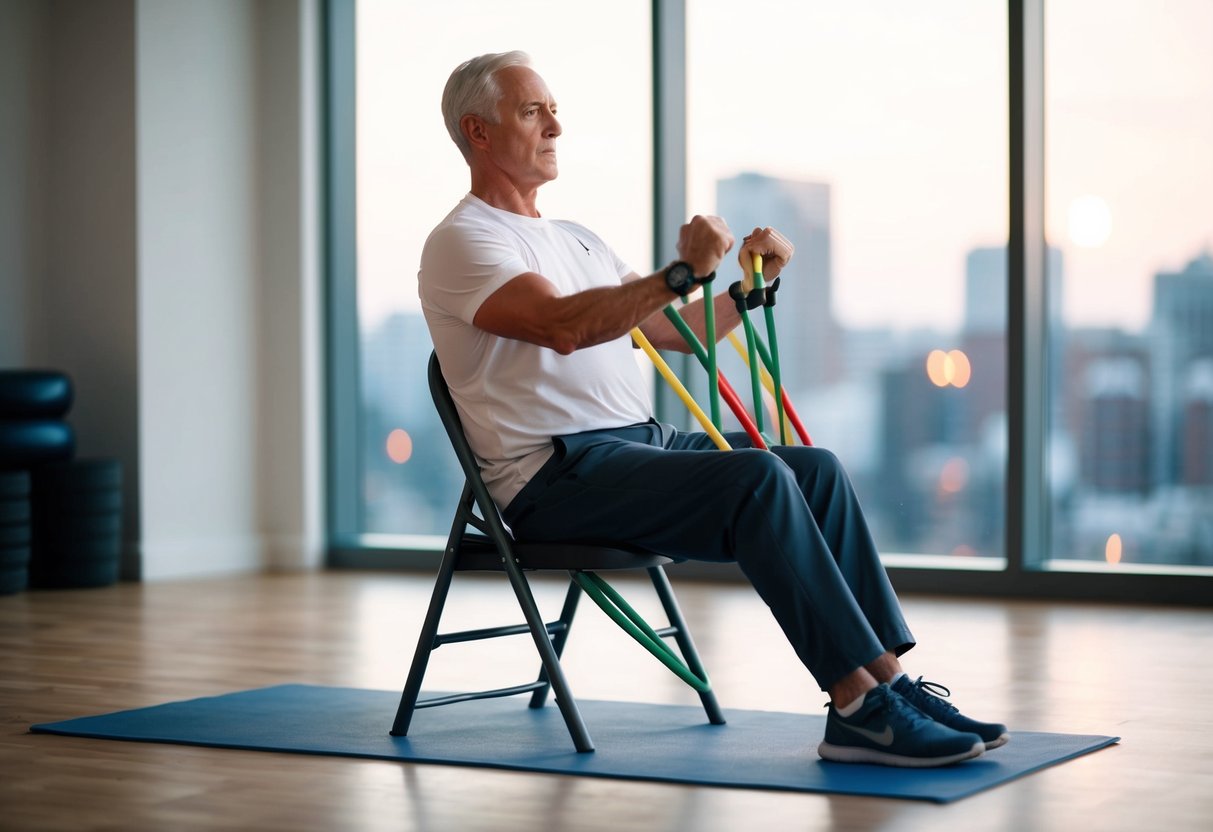Looking to add a little extra strength to your workouts without all the heavy lifting? Isometrics might be just what you need! This low-impact, joint-friendly technique is perfect for seniors who want to build muscle, improve stability, and boost overall fitness. The best part? You don’t need any fancy equipment—just your body and a few simple moves. Let’s dive into how you can easily incorporate isometrics into your fitness routine, keeping things safe, effective, and enjoyable!
How to Incorporate Isometrics into Your Senior Fitness Routine: Simple Strength-Building for Older Adults
Staying active as we age is key to maintaining health and independence. Isometric exercises offer a great way for older adults to keep fit. These simple movements can help build strength without putting stress on your joints.

You can easily add isometric exercises to your daily routine to improve your strength and balance. These exercises involve holding a position for a set time, which makes them perfect for seniors. You don’t need any special equipment, and you can do them almost anywhere.
Isometric exercises are safe and effective for seniors. They can help you stay strong and mobile as you age. By adding these exercises to your fitness plan, you can boost your overall health and well-being.
Key Takeaways
- Isometric exercises can improve your strength and balance without straining your joints
- You can do these exercises anywhere, with no special equipment needed
- Regular practice can help you stay independent and active as you age
Benefits of Isometrics for Seniors
Isometric exercises can be a great addition to your fitness routine as you age. These simple yet effective movements offer many advantages for older adults. Isometric exercises are gentle on your joints. This makes them ideal if you have arthritis or other joint issues. You can build strength without putting extra stress on your body.
These exercises can help improve your balance and stability. Better balance means a lower risk of falls, which is crucial as you get older. You can do isometrics almost anywhere, anytime. No special equipment is needed for many of these exercises. This makes them very convenient for your busy lifestyle.
Isometric training can boost your overall fitness. It helps build muscle strength and can even improve your cardiovascular health. These exercises are easy to learn and perform. You don’t need to worry about complex movements or routines. Simply holding a position can be beneficial.
Isometrics can help you maintain your independence. By strengthening key muscle groups, you’ll find daily tasks easier to manage.
Understanding Isometrics

Isometric exercises can boost your strength without moving a muscle. These simple yet powerful exercises are great for seniors looking to stay fit and strong.
Defining Isometric Exercises
Isometric exercises are strength-building activities that don’t require movement. You hold a position that tenses your muscles without changing their length. Think of pushing against a wall or holding a plank position. Your muscles work hard, but you’re not moving. This type of exercise is easy on your joints, making it perfect for seniors.
Some common isometric exercises include:
- Wall sits
- Planks
- Dead hangs
- Isometric bicep curls
You can do these exercises almost anywhere, with little to no equipment.
How Isometrics Improve Muscle Strength
Isometric exercises build strength at specific joint angles. When you hold a position, you’re training your muscles to be stronger in that exact spot. This targeted strength can help you in daily activities. For example, stronger arm muscles from isometric bicep curls can make it easier to carry groceries.
Isometrics also improves your muscle endurance. Holding a position for a long time teaches your muscles to work harder for longer periods. These exercises can even help with balance and stability. Many isometric poses, like planks, work your core muscles. A strong core is key for good balance as you age.
Getting Started with Isometrics

Isometric exercises are easy to start and can fit into your daily routine. They don’t need fancy equipment and can be done almost anywhere. Let’s look at how to begin safely and set good goals.
Consulting with Healthcare Providers
Before you start any new exercise plan, it’s smart to talk to your doctor. This is extra important if you have health issues or haven’t been active lately. Your doctor can tell you if isometrics are safe for you.
They might suggest changes to make the exercises work better for you. They can also help you understand how isometrics fit with any medicines you take. A physical therapist can show you how to do isometrics the right way. They can teach you the correct form to avoid hurting yourself.
Setting Realistic Goals
Start small with your isometric exercises. Maybe try holding a wall sit for 10 seconds at first. You can slowly make it longer as you get stronger. Set goals that make sense for you. Think about what you want to achieve. Do you want to:
- Improve your balance?
- Make everyday tasks easier?
- Reduce joint pain?
Write down your goals. This helps you stay on track. Remember, progress takes time. Be patient with yourself. Try to do isometrics 2-3 times a week at first. You can do more as you get used to them. Listen to your body and rest when you need to.
Designing an Isometric Workout
Creating an isometric workout plan involves picking the right exercises, adding variety, and setting a good schedule. Here’s how to build a routine that works for you.
Choosing the Right Exercises
Start with simple yet effective isometric exercises. Pick moves that target different muscle groups. Good options include wall sits for legs, planks for the core, and doorway chest presses for the upper body.
Try these basic isometric moves:
- Wall push: Stand facing a wall, and push with your hands.
- Glute bridge holds: Lie on your back, lift your hips, and hold.
- Dead hang: Hang from a sturdy bar without moving.
Pick exercises you feel comfortable doing. If you’re not sure, ask a fitness trainer for help.
Incorporating Variety and Balance
Mix up your routine to work all major muscle groups. This helps prevent boredom and ensures you’re getting a full-body workout.
Try this balanced approach:
- Upper body: Wall pushes, doorway chest presses
- Lower body: Wall sits, static lunges
- Core: Planks, hollow body holds
Add new exercises as you get stronger. You might start with wall sits and move to single-leg wall sits later. This keeps your workout challenging and fun.
Determining Duration and Frequency
Start with short holds and build up over time. Aim for 10-30 second holds at first. As you get stronger, try holding for up to 60 seconds.
Here’s a sample weekly plan:
- Monday: Upper body isometrics
- Wednesday: Lower body isometrics
- Friday: Core isometrics
Do each exercise 2-3 times per session. Rest for 30-60 seconds between holds. Gradually increase the duration of your holds as you get stronger. Listen to your body. If you feel pain, stop the exercise. It’s okay to start slow and build up over time. The key is to be consistent and patient with your progress.
Safe Practice Principles

Staying safe while doing isometric exercises is key for seniors. Follow these tips to get the most benefit while avoiding injury. Pay attention to proper form and listen to your body’s signals.
Warm-Up and Cool-Down Techniques
Start with a 5-10 minute warm-up to get your muscles ready. Try gentle walking in place or arm circles. This helps boost blood flow and limbers up your joints. After your workout, cool down for 5-10 minutes. Do some light stretches to help your muscles relax. This can cut down on soreness later.
Isometric exercises are great for seniors but always ease into new moves. Start with short holds of 5-10 seconds. Build up to longer holds as you get stronger.
Breathing and Technique Tips
Breathe steadily during isometric holds. Don’t hold your breath. Try to breathe in through your nose and out through your mouth. Keep good form. Stand or sit tall with your shoulders back. Engage your core muscles to support your spine.
For standing exercises, stay close to a chair or wall for support if needed. This gives you extra stability and safety. Start with 1-2 sets of each exercise. As you build strength, you can add more sets or hold for longer.
Understanding and Listening to Your Body
Pay close attention to how you feel during and after exercise. Some muscle tension is normal, but sharp pain is not. Stop if you feel dizzy or short of breath. Know your limits. It’s okay to take breaks between exercises. Drink water to stay hydrated.
If you have health issues like high blood pressure or heart problems, talk to your doctor first. They can help you pick safe exercises for your needs.
Progress Monitoring and Adaptation

Keeping track of your isometric exercise routine helps you stay motivated and make changes when needed. This lets you see improvements and adjust your workouts to match your fitness level.
Tracking Progress Over Time
Start by writing down the exercises you do, how long you hold each position, and how many times you repeat them. You can use a simple notebook or a fitness app on your phone. Take note of how you feel after each workout. Are certain exercises getting easier? Can you hold positions longer? These are signs you’re getting stronger.
Try measuring your strength every few weeks. For example, see how long you can hold a wall sit or plank. Write down these times to track your progress.
Adjusting the Routine as Needed
As you get stronger, you’ll need to change your routine to keep improving. This is normal and good for your fitness. If exercises feel too easy, try holding positions longer. For a wall sit, aim to add 5-10 seconds to your hold time. Or, do more repetitions of each exercise.
You can also try new isometric exercises to work different muscles. This keeps your routine fresh and fun. If you feel pain or discomfort, it’s okay to make exercises easier. You might need to hold positions for less time or do fewer repetitions. Remember, safety comes first in your fitness journey.
Isometric Exercise Examples

Isometric exercises are great for seniors. They help build strength without moving. Here are some easy ones to try at home.
Static Arm Curls
- Static arm curls work your biceps. You’ll need a dumbbell or heavy object for each hand.
- Stand up straight. Hold the weights at your sides. Bend your elbows to lift the weights halfway up. Stop there.
- Hold this position for 10-30 seconds. Don’t move your arms. You should feel your muscles working.
- Breathe normally. If it’s too hard, use lighter weights.
- Do 3 sets. Rest for 30 seconds between each set. This exercise builds arm strength without stress on your joints.
Wall Sits
- Wall sits target your legs and core. They’re good for balance too.
- Find an empty wall. Stand with your back against it.
- Slowly slide down until your knees are bent at 90 degrees. Your thighs should be parallel to the floor.
- Hold this position. Start with 10 seconds. Work up to 30 seconds or more as you get stronger.
- Keep your back flat against the wall. Don’t let your knees go past your toes. If it hurts, slide up a bit.
- Do 3 sets. Rest for 1 minute between sets. Wall sits are great for seniors because they’re low-impact.
Plank Holds
- Plank holds work your whole body. They’re especially good for your core.
- Start on your hands and knees. Lower your forearms to the floor. Stretch your legs back. Your body should form a straight line.
- Hold this position. Try for 10 seconds at first. Build up to 30 seconds or more.
- Keep your back straight. Don’t let your hips sag. Look at the floor to keep your neck in line.
- If it’s too hard, put your knees down.
- Do 3 sets. Rest for 1 minute between sets.
- Planks improve core strength and stability. This helps with everyday tasks and prevents falls.
Incorporating Isometrics with Other Exercises

Isometric exercises can be a great addition to your existing workout routine. You can mix them with other types of exercises to create a well-rounded fitness plan. Try adding isometric holds at the end of your usual strength training sets.
For example, after doing bicep curls, hold the weight in the halfway position for 10-15 seconds. During your yoga practice, focus on holding poses for longer periods. This turns many yoga positions into effective isometric exercises.
When doing pushups, pause at the bottom for a few seconds before pushing back up. This adds an isometric element to a dynamic exercise. Use isometrics as active rest between cardio intervals.
Try a wall sit or plank hold while catching your breath between jogging or cycling bursts. Don’t forget to include isometric exercises for your core. The dead hang from a pull-up bar is an excellent way to work your abs and grip strength at the same time.
Overcoming Common Challenges

Facing Hurdles with Isometrics? Here’s How to Overcome Them:
Balance Issues:
Feeling unsteady? Try isometric exercises near a wall or chair for extra support. This way, you can build strength while staying safe and secure.
Joint Pain:
Start gently with short holds, and gradually increase the duration as you get comfortable. Always listen to your body—stop if you experience pain.
Boredom:
Keep things fresh by switching up your routine! Try these exercises to keep it interesting:
- Wall sits
- Plank holds
- Dead hangs from a sturdy bar
Fatigue:
It’s perfectly fine to take breaks. Start with shorter holds, then slowly work your way up as your strength improves.
Motivation:
Set small, realistic goals, and celebrate every bit of progress. No matter how tiny it seems, you’re moving forward! You’ve got this!
Fun Fact
Did you know that isometrics can actually improve your posture? By targeting key muscles in your core and back, isometric exercises help strengthen the muscles that support your spine, allowing you to stand taller and feel more aligned. Over time, this increased stability can lead to better posture, which not only enhances your appearance but also reduces strain on your back. This can help prevent or even alleviate chronic back pain, making everyday activities more comfortable and pain-free. Plus, better posture means more confidence—win-win!
Isometrics: A Powerful Tool for Senior Fitness
Incorporating isometrics into your senior fitness routine is a smart and efficient way to build strength, improve posture, and protect your joints—all without the need for heavy equipment or complicated exercises. Isometric exercises focus on holding specific positions, which activates your muscles without excessive strain on your joints. By starting with simple holds like wall sits or planks, and gradually increasing the duration as you grow stronger, you’ll experience the benefits of enhanced muscle endurance, balance, and core stability.
What’s even better is the flexibility of isometrics—you can perform these exercises almost anywhere, whether at home, outdoors, or even while waiting in line! This makes them perfect for fitting into your daily routine, no matter your schedule. So, if you’re looking for a low-impact yet effective way to boost your fitness, support healthy aging, and enhance your overall well-being, isometrics are an excellent addition to your workout regimen.
Ready to add isometric exercises to your fitness routine? Share your experiences and tips with our community. Let’s inspire each other to stay strong and healthy.
Frequently Asked Questions

Isometric exercises can be a great addition to a senior fitness routine. They help build strength and stability without putting too much strain on joints. Let’s look at some common questions about isometrics for older adults.
What are the best isometric exercises for individuals over 60?
Wall sits and planks are excellent isometric exercises for seniors. They work multiple muscle groups and can be adjusted to different fitness levels. Glute bridges are also good for strengthening the lower body. For upper body strength, try isometric bicep curls. Hold a lightweight at a 90-degree angle to work your arms without movement.
How often should seniors perform isometric exercises as part of their fitness routine?
You can do isometric exercises 2-3 times a week. This gives your muscles time to recover between workouts. Start with a few exercises and slowly add more as you get stronger. Always listen to your body. If you feel pain, stop the exercise and rest.
Can isometric exercises help manage blood pressure for older adults?
Yes, isometric exercises may help lower blood pressure in some older adults. They can improve heart health when done regularly. But check with your doctor before starting any new exercise program, especially if you have high blood pressure.
What is the recommended duration for holding isometric exercises for seniors?
For beginners, start with 10-15 second holds. As you get stronger, you can slowly increase to 30-60 seconds. Longer holds are good for building endurance. Remember, quality is more important than quantity. It’s better to do shorter holds with good form than longer ones with poor form.
Which isometric exercises are most suitable for beginners in senior fitness?
Wall push-ups are great for beginners. They work your chest and arms without putting stress on your joints. Seated leg lifts are another good option. They strengthen your leg muscles while you sit in a chair. Hollow-body holds can help build core strength. If you’re new to exercise, start with easier versions.
What precautions should seniors take when incorporating isometric exercises into their workout regimen?
Start slow and listen to your body. Don’t hold your breath during exercises. Breathe normally to avoid raising your blood pressure too much. If needed, use a chair or wall for support. This can help prevent falls. Stop if you feel dizzy or have chest pain. Talk to your doctor before starting if you have any health concerns.

